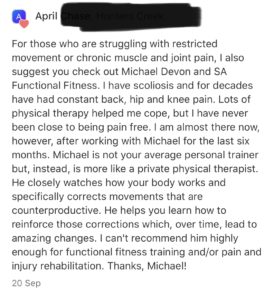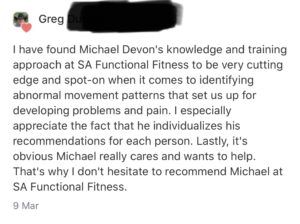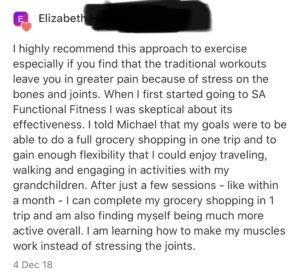The exercises we teach at this gym don’t look like your typical gym exercises and you must think that they don’t build muscle or they don’t build strength. What you don’t realize is that they support muscle integration from multiple chains of muscle in a manner that replicates the dynamics of human movement (weight transfer, contralateral reciprocation, total body integration, etc.) and promotes muscular and neurological balance through the system. Key ingredients for a strong body for life versus a strong body for exercises that don’t carry over to life dynamics.
Our team of trainers don’t just stand around and count reps because there is more to exercising than just doing this exercise for 15 reps, and then this one, and then this one, only to get your heart rate up and break a sweat. That’s important but there is more to it because, if you’re just going through the motions then you could be using the wrong muscles to perform the exercise.
We want to teach you how to contract a muscle properly and at the correct time. In doing so, your body will begin to reprogram new functions to support your movement patterns- during exercise and real life! Without muscles contracting to move your body, your joints begin to pick up the slack and wear and tear is induced in parts of the body that aren’t capable of handling the demand. This is when injury risk goes up and aches and pains creep in.
If you want to avoid injuring yourself and inflicting pain, that can be prevented, then you must learn how to move well and what muscle functions are involved in certain movements. The better you can execute muscle functions during exercises, the better those functions will manifest in reality when you’re walking, running, playing sports, or just living in real world conditions.
The secret is that the exercises you perform must mirror the way your body performs in the real world. So when you’re doing the same exercises you did in high school athletics, or what you read in a fitness magazine, or what you see other gym goers doing, your body is missing out on the crucial variables that separate ‘moving your body” from moving your body, using the correct muscles to control ranges of motion and functions that your body should be capable of performing in the real world without pain. In short, you’re either habitually going through the motions the way your body defaults to movement patterns or you’re using your muscle functions to intentionally control those motions and re-train the way your body moves through ranges or motion. A lot of times the traditional, conventional exercises that you can perform by “monkey see, monkey do” don’t replicate the way your body moves in reality and that can cause misuse and misfiring of muscles when you’re just trying to move in general.
Exercise is more complex than seeing an exercise and then doing what you see, because without the proper understanding of what you should be feeling and how your body should be functioning you could be training your body to contract the wrong muscles and compensate your way through an exercise, which leads to performing poorly for the dynamics of the real world.
As pictured, the exercises in this gym allow the body to move through the dynamics that compose human movement. The more skilled you become at these types of exercises, the more carry over those exercises have to life outside of the gym. Which is what your body needs, to function without aches and pains. When executed properly, the exercises we teach offer the combined benefit of strength training and physical rehabilitation at once.
Before you write these exercises off because they don’t look tough, don’t require lifting heavy weight, or look like dance moves consider this, maybe the way we’ve been taught to exercise as athletes, bodybuilders, powerlifters, yogis, etc., is incomplete. Maybe it’s too much for the body because the body hasn’t mastered the basics of fundamental movement. Aka human biomechanics, the complex intricate details about the way the human body moves around, and then creating and teaching exercises that match up to that movement. If you don’t train these fundamentals, how can something like lifting a heavy bar, on your spine, up and down, or moving through extreme ranges of motion, or even moving through ranges of motion that our body didn’t evolve to do, like animal crawls. Maybe all of this has some good intentions behind the practices but if our muscles evolved primarily from movements like walking, running, and throwing, then we should train those movements and create exercises around those movements. Instead of movements that we create for sport or ego boosts or just arbitrary patterns that our body, literally, at a functional level, should never have to go through- like a crab crawl or a warrior pose. Maybe we need to be a little more critical about the repercussions from some exercise practices, and the long term effects they have on your fitness, joint health, total body function, and pain. Maybe then, the need for rehab will go away, if we build strength around the movements we do most, rather than exercises that limit your strength to that exercise (in a gym and not outside in the real world). If your body is strong at what you do most, then it compensates less and has more functional capacity.
So remember, if you want to be strong, you have to be efficient at what you do most. Come try a month with us and we’ll teach your muscles how to function, in the way that your body moves, to build the strength that you need to navigate the demands of the real world!









